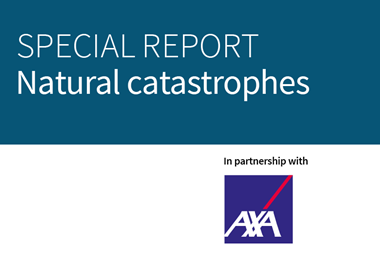The construction sector is pioneering new solutions for buildings capable of withstanding the worst earthquakes

As the practice of designing new buildings develops, many clever new ideas on how to improve earthquake resilience are emerging. Whether performance-based design, whereby building owners can set specific criteria for what they want from a structure in the event of an earthquake, or contemporary engineering solutions like displacement or deformation, or an emerging fashion for prefabrication, there are plenty of options for risk managers to consider. Increasingly, these factors are used in assessing earthquake risk and pricing earthquake insurance.
Swedish white goods manufacturer AB Electrolux took a strategic decision to invest in fast-growing South American markets, acquiring Compañia Tecno Industrial, in 2011, at which point Lennart Edström, vice president, group risk management, began to look at the seismic risk. Chile is in the Pacific Ring of Fire, one of the most active seismic zones on earth. In 2010, it was hit by a magnitude 8.8 quake, among the most powerful in recorded history, affecting two million people and damaging several hundred thousand buildings.
Edström says: “If you want to be in the market, you have to be there. You can’t say, ‘because there are earthquakes every now and again, we’re not going to sell to you guys’. It was a business decision, and we have to handle the risk. We have one big factory in Chile. I send our loss prevention guys to do Electrolux Blue Risk assessment, where we measure 25 parameters annually. Nat cat is one of these. We then take that information and decide whether to bring the risk into the captive, or to take it outside because of the risk level.”
“We mitigate and transfer risk. We want to transfer the risk because, if it’s a really big earthquake, with its epicentre near our factory, it could be wiped out.”
Edström is now preparing to fly to the Chilean capital, Santiago, following a magnitude 8.3 earthquake which hit just off the coast near Tongoy in September. “We are assessing if there has been any damage to the structure of the building, or to water, or electricity supplies. Did everything work, despite the earthquake? This will tell me what level of resilience we have against this kind of event.”
Looking at the effect of earthquakes on different structures is the best way to understand the damage that can happen. Soil liquefaction caused by a magnitude 6.3 earthquake in Christchurch, New Zealand, in 2011, gave engineers the chance to study how building structures coped, while the magnitude 5.9 L’Aquila earthquake in central Italy in 2009, prompted AXA Matrix Risk Consultants and University of Naples Federico II to develop a new approach to seismic risk assessment which takes account of how different structures cope.
Michael Gustafson, industry strategy manager, structural engineering, at Autodesk, a 3D design software house, studied the effects of a magnitude 6.7 earthquake at North Ridge, California in 1994, for his masters degree in civil engineering. “It was a significant event in terms of infrastructure damage, and there was a lot of research on the performance of the damaged structures,” Gustafson says.
“Mine was on steel construction and the way that steel structures perform, looking at things like welding procedures.”
His findings were incorporated into future building codes.
Knowledge about the seismic vulnerability of buildings can help risk managers identify which of their properties are most at risk.
Seismic Risk Gap Assessment, the first of three stages within AXA’s new approach, prioritises the risks within a portfolio. It does this by comparing the country building codes in force at the time when the building was designed to a contemporary standard code.
“Comparing the seismic demand of today’s codes with those which were in force at the time when the building was designed gives us a proxy for the seismic performance gap of a structure,” says Fabio Petruzzelli, seismic risk specialist, AXA.
A growing body of knowledge about seismic design is also improving earthquake resilience, says Gustafson, who points to performance-based design (PBD), as a significant step forward. “PBD allows the owner to determine the appropriate level of performance for the building, rather that simply to follow building code requirements,” says Gustafson. When designing a hospital for instance, the owner could set criteria that allows for damage to certain parts of the structure which are not critical to the functioning of the facility.
“You don’t really know what type of seismic event will happen. It’s just the weather, it’s probabilistic. PBD enables owners to specify how they want that building to perform in the event of an earthquake,” Gustafson says.
Engineers can then use a method like displacement; base isolation is an example of this— akin to mounting the building on roller skates, it minimises the amount of force from an earthquake by disconnecting the structure from the earth. Or they can use deformation, which takes the force of the earthquake and focuses it on very specific parts of the building where they want it to focus. Motor vehicles whose structures crumble easily even in a minor accident use deformation design, because it protects the driver and passengers by absorbing the impact of the crash into the vehicle structure.
Prefabrication is increasingly used in seismic design, because structures built in a controlled environment are more reliable than those put together in the field, whose construction is subject to variables such as materials, workmanship, and the weather. “Owners can use these engineering methods to make their buildings safer and more reliable,” Gustafson says.
These kind of factors are taken into account in the second stage of AXA’s risk evaluation, Frame@ Risk, which enables a desktop loss assessment of a building. The third stage involves a site visit by seismic risk specialists and structural engineers, and computer-simulated modelling of seismic fragility.
Meanwhile for his trip to Santiago, Electrolux’s Edström is preparing to keep a sharp eye out for any signs of seismic impact. “If we build a new factory in an earthquake zone, we build it to be seismically safe. It costs a lot more, but we do it anyway. So it should be able to resist an earthquake,” he says. “But, if it’s a really big one [earthquake], who knows?”




















No comments yet